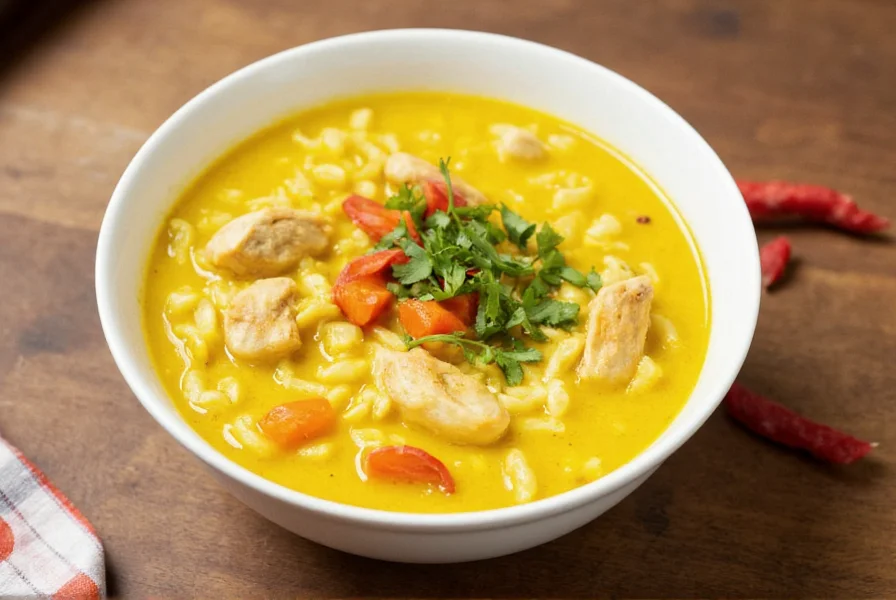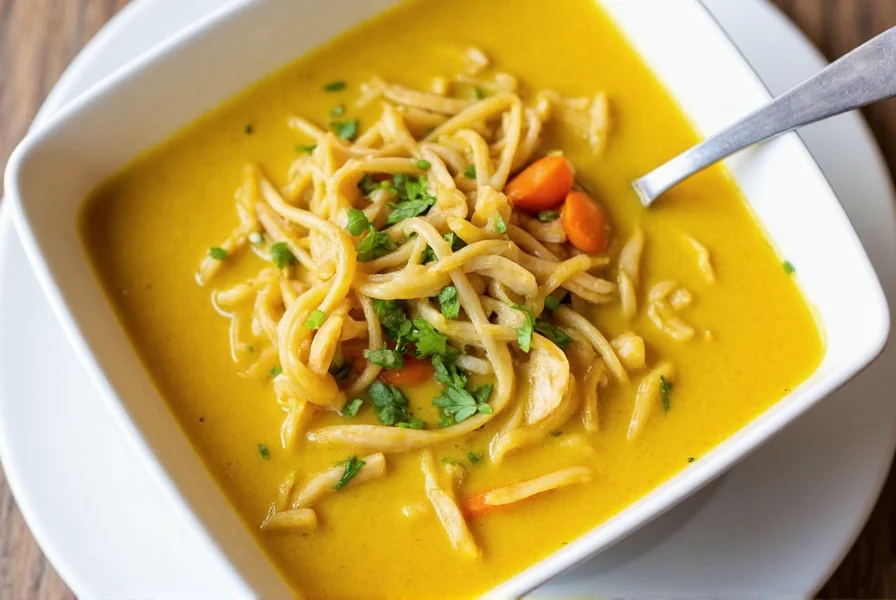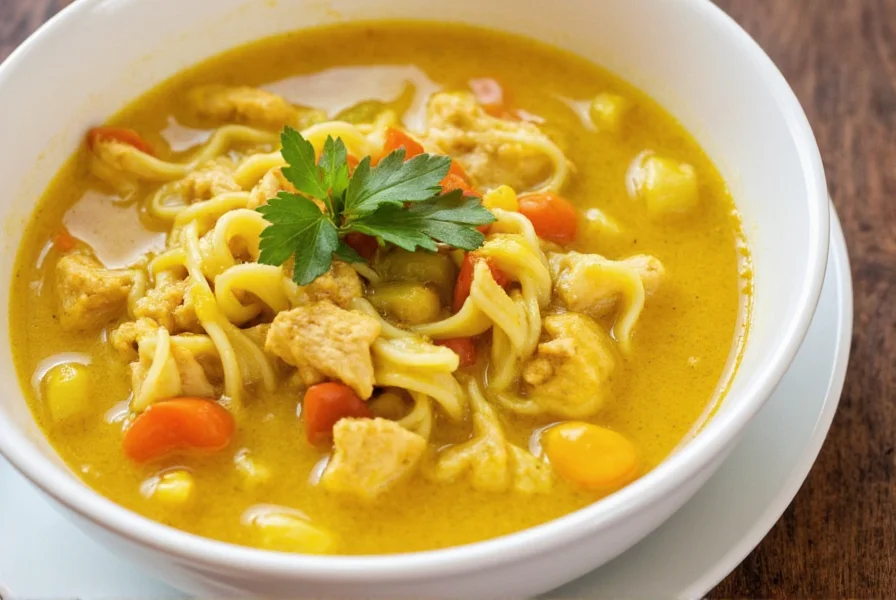Turmeric chicken noodle soup has surged in popularity as home cooks seek to elevate classic comfort food with functional ingredients. This vibrant dish transforms the familiar chicken noodle soup template by incorporating turmeric, creating a nutritionally enhanced version that maintains all the soothing qualities of the original while adding scientifically supported health benefits.
The Science of Turmeric in Soup Form
What makes turmeric particularly effective in soup preparation? The liquid medium of soup creates ideal conditions for curcumin absorption. When turmeric is simmered in broth with black pepper (which contains piperine) and healthy fats like olive oil or coconut milk, its bioavailability increases by up to 2,000% according to research published in Planta Medica. This "golden milk" principle applies equally to soup preparation.
Unlike taking turmeric supplements on an empty stomach, incorporating it into a balanced soup provides:
- Natural pairing with absorption-enhancing ingredients
- Gradual release of compounds through slow digestion
- Synergistic effects with other anti-inflammatory ingredients like garlic and ginger
- Hydration benefits that support overall wellness
Traditional vs. Turmeric-Enhanced Chicken Noodle Soup
| Feature | Traditional Chicken Noodle Soup | Turmeric Chicken Noodle Soup |
|---|---|---|
| Primary Health Benefit | Hydration, electrolyte balance | Anti-inflammatory, immune support |
| Active Compounds | L-cysteine from chicken | Curcumin + piperine combination |
| Color Profile | Clear golden broth | Vibrant yellow-orange broth |
| Optimal Consumption Timing | During illness | Preventative daily or during illness |
| Flavor Complexity | Simple savory | Earthy, warm, complex |
Perfect Turmeric Chicken Noodle Soup Recipe
Creating an authentic turmeric chicken noodle soup requires attention to ingredient quality and preparation technique. The following anti-inflammatory turmeric chicken soup recipe serves four and takes approximately 45 minutes from start to finish.
Ingredients for optimal turmeric chicken noodle soup with bone broth
- 6 cups organic chicken bone broth (homemade preferred)
- 1.5 lbs boneless, skinless chicken thighs (more flavorful than breasts)
- 3 tbsp fresh turmeric, grated (or 1.5 tbsp high-quality ground turmeric)
- 1 tbsp freshly grated ginger
- 4 cloves garlic, minced
- 1 black peppercorn per serving (crushed)
- 2 tbsp coconut oil or olive oil
- 2 medium carrots, sliced
- 2 celery stalks, sliced
- 3 oz gluten-free noodles or rice noodles
- 1 lemon, juiced
- Fresh parsley for garnish
- Optional: 1/4 cup full-fat coconut milk for enhanced curcumin absorption
Step-by-step preparation for homemade turmeric chicken soup
- Heat coconut oil in large pot over medium heat
- Add grated turmeric, ginger, and crushed black pepper - sauté for 1 minute to activate compounds
- Pour in bone broth and bring to gentle simmer
- Add chicken thighs, carrots, and celery - simmer for 20 minutes
- Remove chicken, shred, and return to pot
- Add noodles and cook according to package directions
- Stir in lemon juice and optional coconut milk just before serving
- Garnish with fresh parsley
Pro tip for maximum health benefits of turmeric soup: Never boil turmeric vigorously as high heat can degrade curcumin. Maintain a gentle simmer throughout preparation. The addition of lemon juice not only brightens flavor but also helps preserve the turmeric's beneficial compounds.
Why Bone Broth Makes the Difference
When preparing turmeric chicken noodle soup for immunity, the broth base matters significantly. Bone broth contains collagen, gelatin, and amino acids like glycine that work synergistically with turmeric's compounds. Studies suggest these components enhance the anti-inflammatory effects while supporting gut health - crucial since 70% of our immune system resides in the digestive tract.
Homemade bone broth provides superior nutrition compared to store-bought varieties, but if using commercial broth, look for:
- No added sugars or artificial ingredients
- Organic certification
- Visible gelatin content when cold
- Simmered for at least 12 hours

Serving Suggestions and Storage Tips
For maximum therapeutic benefit, consume turmeric chicken noodle soup while still warm but not scalding hot. The ideal temperature preserves the active compounds while providing soothing relief. Pair with a small side of fermented vegetables like sauerkraut to further enhance gut health and nutrient absorption.
Storage guidelines for turmeric soup leftovers:
- Refrigerate for up to 4 days in airtight container
- Freeze without noodles for up to 3 months
- Reheat gently without boiling to preserve curcumin
- Always add fresh lemon juice when reheating
For those following specific dietary protocols, this turmeric-enhanced chicken soup adapts well to paleo, gluten-free, and Whole30 requirements by simply selecting appropriate noodle alternatives or omitting them entirely.
Common Questions About Turmeric Chicken Noodle Soup
Does turmeric chicken noodle soup really have anti-inflammatory benefits?
Yes, when prepared correctly with black pepper and healthy fats, turmeric chicken noodle soup delivers significant anti-inflammatory benefits. Research shows curcumin, turmeric's active compound, can inhibit multiple inflammation pathways. The soup format enhances absorption compared to dry supplements, making the benefits more accessible to your body.
How much turmeric should I use in chicken noodle soup for health benefits?
For therapeutic benefits, use 1-2 teaspoons of ground turmeric or 1-2 tablespoons of fresh grated turmeric per serving. Remember to include black pepper (at least 1/8 teaspoon per teaspoon of turmeric) and a healthy fat source like olive oil to increase absorption by up to 2,000%. Using less than this amount provides flavor but minimal therapeutic benefit.
Can I make turmeric chicken soup without chicken for vegetarian option?
Absolutely. For a vegetarian anti-inflammatory soup, substitute chicken with white beans or chickpeas for protein, and use high-quality vegetable bone broth. Add mushrooms for umami flavor and extra immune support. The turmeric benefits remain equally effective in vegetarian preparations when combined with black pepper and healthy fats.
Why does my turmeric soup taste bitter?
Bitterness in turmeric soup usually results from using too much turmeric, boiling instead of simmering, or using low-quality turmeric powder. Fresh turmeric is less bitter than dried. To fix bitterness, add a small amount of acid (lemon juice or apple cider vinegar) or a touch of sweetness (a pinch of coconut sugar). Properly prepared with quality ingredients, turmeric should impart earthy warmth without bitterness.
How often can I safely consume turmeric chicken noodle soup?
For most people, consuming turmeric chicken noodle soup daily is safe and beneficial. The recommended daily intake of curcumin is up to 500-2,000 mg, which translates to about 1-3 teaspoons of turmeric powder in food preparation. Those with gallbladder issues or taking blood thinners should consult their healthcare provider before regular consumption.

Creating the perfect turmeric chicken noodle soup balances culinary tradition with modern nutritional science. By understanding the synergy between ingredients and preparation methods, you can transform this classic comfort food into a functional meal that supports year-round wellness. Whether you're fighting off a cold or simply seeking to reduce inflammation through diet, this golden variation on a classic delivers both comfort and measurable health benefits.











 浙公网安备
33010002000092号
浙公网安备
33010002000092号 浙B2-20120091-4
浙B2-20120091-4